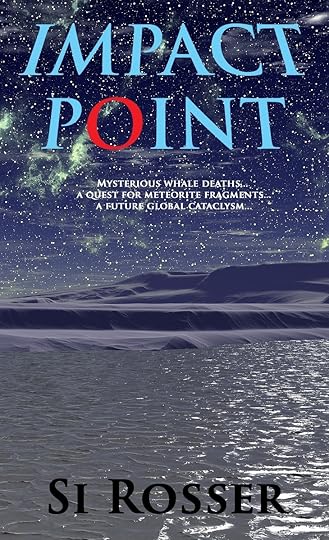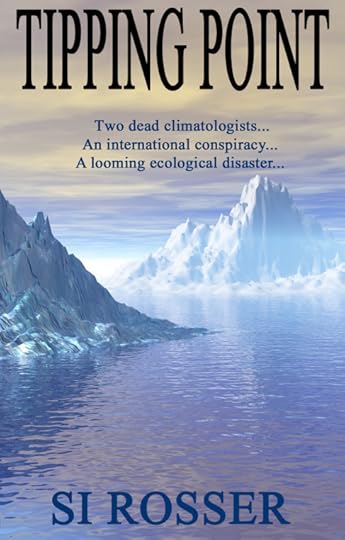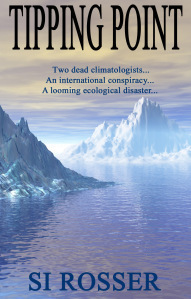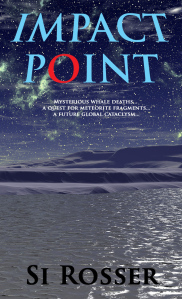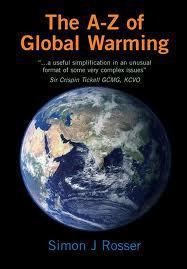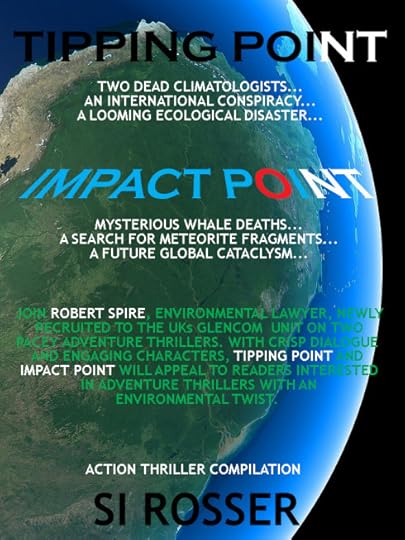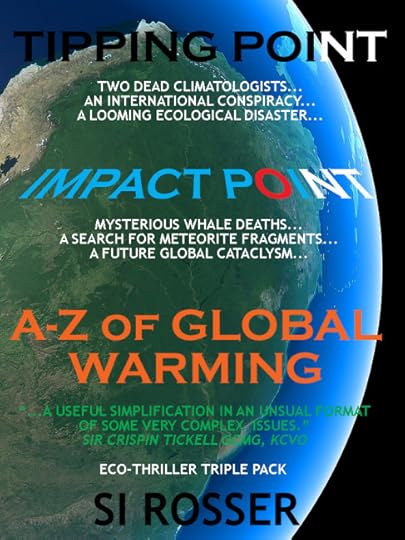Simon Rosser's Blog, page 4
June 24, 2012
Wimbledon or Washout?
Wimbledon starts tomorrow! I love Wimbledon, or I should say, I used to love Wimbledon when it was filled with players like John McEnroe, Bjorn Borg, Jimmy Connors, Ivan Lendl, Boris Becker, Steffi Graph, Chris Everett and Martina Navaratalova! Yep, I’m showing my age a bit here, but looking back, I have fond memories of great matches involving the above players, exciting rallies and of course long hot summers…
When I look back at some of the matches, I must have been only 12, hard to believe, but my best memories of Wimbledon are from around that age until I was in my late twenties – so around 1995 I guess. By that time, most of the above players had played their last matches and my memories of the Wimbledon tournament are of newer but far less exciting players and matches – and bad weather!
The only benefit of the rained off matches is that sometimes the old classic games are shown on T.V!
The Wimbledon weather this year is looking distictively wet towards middle of the first week - no surprises there – which will mean the tournament going into three weeks possibly, so plenty of time to show old matches maybe? If not, I’ve dredged a few up from U-Tube anyway so in case you’ve all forgotten, you can see what I mean…
First off, some John McEnroe classic tantrums – not Wimbledon, but who cares?!
http://www.youtube.com/watch?v=YxAPKtOe0fQ
And;
http://www.youtube.com/watch?v=wcWNsS6wEps
What about the classic tie break with McEnroe and Borg in 1980?
http://www.youtube.com/watch?v=6qaweRhyAxk
Or this 1986 Becker and Lendl final;
http://www.youtube.com/watch?v=W1NcGiBCHDs
A lot of people say that the reason for those great rallies is because of the older wooden raquets the players used. The modern raquets just give too much speed, meaning the game is all about power shots, rather than exciting rallies, and this seems to be true. Ahh well, it’s a good job the older classic matches are still available to watch, especially on a rained off Wimbledon day.
If you get really bored of the rained off tennis, then there’s always Robert Spire action-adventure thrillers TIPPING POINT, IMPACT POINT and for anyone interested in the bad weather and climate, THE A-Z OF GLOBAL WARMING!
Enjoy the Wimbledon fortnight, and just remember – it used to be so much better!








May 20, 2012
The Tunguska Event
Just after 7 AM on June 30th 1908 a massive air blast occurred over Tunguska in Siberia – the Tunguska event – caused by a meteorite or comet fragment. The blast released the same amount of energy as 185 Hiroshima nuclear bombs. The object is thought to have been around 120 feet in diameter. It will happen again, it’s just a question of where and when…
Ever since I first saw a picture of the flattened trees radiating out from a central location in a desolate region of Siberia when aged about 11, I was fascinated by what could have caused the devastation that occurred there in 1908. Various theories were put forward;
A crashed UFO
A miniature black hole striking the Earth
Antimatter collision
Or of course an exploding comet fragment of meteorite.
Well, recently Italian scientists who have been searching for remnants and evidence of what could have caused the explosion, think they may have found evidence of a stony fragment at the bottom of lake Cheko. The story can be read HERE.
I also found a great U-Tube video taken from the wonderful Carl Sagan’s cosmos program. It’s not on long and well worth a watch.

Fascinated and equally concerned by the event, I decided to weave the facts into an action thriller, which turned into Robert Spire’s second adventure IMPACT POINT. Why not click on ‘Look Inside’ on the Amazon page and read the first few chapters…








May 7, 2012
IMPACT POINT Kindle Book : What The Readers Are Saying.
Check out a sample of Amazon reader reviews for IMPACT POINT. At £1.99/$2.99 why not give it a go and see what you think?
“This is the author’s second Robert Spire thriller and I was looking forward to it after reading Tipping Point. An intriguing mix of environmental thriller and sci-fi action as we follow environmental lawyer Robert Spire who – since his first adventure in Tipping Point – has now been signed up to GLENCOM, a kind of environmental MI6. He is asked to investigate, after the discovery of two dead blue whales, and is assisted by an attractive San Diego-based marine biologist and ex-marine Travis Dexter as he travels to some exotic locations in search of answers to the whale deaths and a meteorite stolen from the home of a Californian based philanthropist. The book is an unique blend of environmental, sci-fi and action adventure thriller which becomes more sinister as the adventure proceeds. The Impact Point of the title is soon revealed. A seemingly well researched and enjoyable read.”
“I can recommend this book as an entertaining, exciting read. I intend to purchase more titles by this author in the near future.”








TIPPING POINT Kindle thriller: What The Readers Are Saying.
Check out a sample of Amazon reader reviews for TIPPING POINT. At £1.99/$2.99 why not give it a go and see what you think?
“This is a nice and easy read, and overall likable. I could deduce the following forumla:
- take the science from the ‘The Day After Tomorrow’
- take an ex- KGB assassin from Fredrick Forsyth
- mate Jack Reacher (Lee Child) with John Grisham’s lawyer to produce a wanna-be James Bond
- Bring in twists and turns of a James Bond movie.
- Borrow a punchline from Bond – “My name is Spire, Robert Spire”!!
- Shake them well
Viola! You have the ‘Tipping Point’. Mind you, I am not bad-mouthing this novel, just giving you a feel of what to expect. Rosser has done an appreciable job of blending all the elements together, and such an effort from a working professional balancing his day-time job, family and life, is commendable. I like this for the fun read this was, for the sincere effort of the author, and obviously, the story that was interesting enough for wanting to turn the page.”
COMPELLING STORY ABOUT A VERY CURRENT ISSUE
“Really enjoyed this fast paced book and the characters were very believable. The content was very interesting and I did wonder if it was all fantasy or whether there was any fact to it!”








April 29, 2012
Kindle Book Publishing And Promotion
Whether you’re a newbie publisher or a more established author, here is a trio of books from established authors that I found very useful and interesting. The following Kindle books are targeted at Kindle book publishing and Kindle book promotion.
First off John Locke’s How I Sold A Million eBooks In 5 Months.
John Locke, as i’m sure you all know – unless you’ve been on a desert island someplace – holds the mantle for becoming the world’s first self published Kindle author to sell over 1 million ebooks. His book on how he did it gives an honest and frank explanation of how he managed it, although I’m sure his books must also be very good to be selling by the bucket load. I’ve not read any yet, but millions have. An example of Mr Locke’s marketing skills is his ability to write a Western – hardly a popular genre – and make it a top selling Kindle book. Follow The Stone is still selling very very well. In fact, we are reminded from his website that “Every 7 seconds, 24 hours a day, a John Locke novel is downloaded somewhere in the world!” Not bad eh?
His book discusses the main promotional tools Twitter and blogging in some detail and his ability to reach potential readers through relevant and touching blogs which it seems go almost viral, spreading the word about his Kindle books in the process. See my Amazon review of his book HERE.
My second recommendation is Michael R Hicks’ book The Path To Self Publishing Success. Mr Hicks is a successful Kindle author with his SciFi “In Her Name” novels and recently gave up his day job after Kindle book sales took off. The guide gives a detailed account of all you need to know to turn your novel into a Kindle published book and then how to go about promoting it. Some interesting stuff about pricing structure, use of Twitter in particular and monetizing websites. Helps arm the author with the right tools to get on the path to Kindle publishing success. His novel Season Of The Harvest and its well worth a read. The authors website can be found HERE.
Finally, we have author J.A Konrath’s A Newbie’s Guide To Publishing. To be honest, I’m still only 75% through this ebook because it is one information-packed guide on literally (no pun intended) everything you need to know about the publishing industry. Here is a list of what the book contains;
BREAKING IN – Over forty essays on how to find an agent and sell your writing.
PUBLISHING – More than twenty essays about the publishing business, and how it works.
PROMOTION – Over fifty essays on marketing, advertising, and self-promotion.
TOURING – Extensive, in-depth details on how to do book tours and signings.
INTERNET – Dozens of essays on how writers can effectively use the world wide web.
EBOOKS – Speculation and real-life examples of digital publishing, the Kindle, print on demand, and self-publishing.
MOTIVATION – Over fifty essays guaranteed to enlighten and inspire your writing efforts.
Mr Konrath is the author of the Jack Daniels thriller series, where each novel is named after a well-known cocktail. His blog, A NEWBIE’S GUIDE TO PUBLISHING is essential reading for anyone wanting an insight into book publishing and promoting.
You really need to read this book to see how much effort this guy puts into promoting, touring and writing. In fact, I have no idea how he has time to blog! Amazing.
I hope this selection of helpful books helps you all in your writing careers. Good luck! Click the following link if you enjoy, or fancy trying ECO-THEMED THRILLERS.








Essential Reading For Budding Kindle Book Authors On Publishing And Promotion
Whether you’re a newbie publisher or a more established author, here is a trio of books from established authors that I found very useful and interesting. The following Kindle books are targeted at Kindle book publishing and Kindle book promotion.
First off John Locke’s How I Sold A Million eBooks In 5 Months.
John Locke, as i’m sure you all know – unless you’ve been on a desert island someplace – holds the mantle for becoming the world’s first self published Kindle author to sell over 1 million ebooks. His book on how he did it gives an honest and frank explanation of how he managed it, although I’m sure his books must also be very good to be selling by the bucket load. I’ve not read any yet, but millions have. An example of Mr Locke’s marketing skills is his ability to write a Western – hardly a popular genre – and make it a top selling Kindle book. Follow The Stone is still selling very very well. In fact, we are reminded from his website that “Every 7 seconds, 24 hours a day, a John Locke novel is downloaded somewhere in the world!” Not bad eh?
His book discusses the main promotional tools Twitter and blogging in some detail and his ability to reach potential readers through relevant and touching blogs which it seems go almost viral, spreading the word about his Kindle books in the process. See my Amazon review of his book HERE.
My second recommendation is Michael R Hicks’ book The Path To Self Publishing Success. Mr Hicks is a successful Kindle author with his SciFi “In Her Name” novels and recently gave up his day job after Kindle book sales took off. The guide gives a detailed account of all you need to know to turn your novel into a Kindle published book and then how to go about promoting it. Some interesting stuff about pricing structure, use of Twitter in particular and monetizing websites. Helps arm the author with the right tools to get on the path to Kindle publishing success. His novel Season Of The Harvest and its well worth a read. The authors website can be found HERE.
Finally, we have author J.A Konrath’s A Newbie’s Guide To Publishing. To be honest, I’m still only 75% through this ebook because it is one information-packed guide on literally (no pun intended) everything you need to know about the publishing industry. Here is a list of what the book contains;
BREAKING IN – Over forty essays on how to find an agent and sell your writing.
PUBLISHING – More than twenty essays about the publishing business, and how it works.
PROMOTION – Over fifty essays on marketing, advertising, and self-promotion.
TOURING – Extensive, in-depth details on how to do book tours and signings.
INTERNET – Dozens of essays on how writers can effectively use the world wide web.
EBOOKS – Speculation and real-life examples of digital publishing, the Kindle, print on demand, and self-publishing.
MOTIVATION – Over fifty essays guaranteed to enlighten and inspire your writing efforts.
Mr Konrath is the author of the Jack Daniels thriller series, where each novel is named after a well-known cocktail. His blog, A NEWBIE’S GUIDE TO PUBLISHING is essential reading for anyone wanting an insight into book publishing and promoting.
You really need to read this book to see how much effort this guy puts into promoting, touring and writing. In fact, I have no idea how he has time to blog! Amazing.
I hope this selection of helpful books helps you all in your writing careers. Good luck! Click the following link if you enjoy, or fancy trying ECO-THEMED THRILLERS.








April 17, 2012
Kindle Direct Publishing: Kindle Book Promotion
KDP Select is a relatively new promotional tool offered by Amazon to their Kindle authors who sign up to a 3 month exclusivity deal when you publish your ebook. You must agree to only publish your ebook on the Amazon Kindle platform to the exclusion of all other e-readers during the 3 month period. In return you get 5 days when you can offer your hard written book for free, and get the benefit of Amazon’s Kindle lending library.
WHAT ARE THE BENEFITS?
You might be thinking? If your book is only available on the Kindle, what about all the lost sales from the other reading devices, The Nook, Sony or I-Pads that you probably service though your Smashwords account? Well, those sales will be lost, but how many sales were you really getting from those sources anyway?
I had 2 books selling via Smashwords and Kindle before I joined KDP Select. THE A-Z OF GLOBAL WARMING (UK) and TIPPING POINT (UK). Combined sales for both on Smashwords were about 10 a month. Sales via Kindle were a combined 30-40 a month. No big deal, but still sales. So, I decided to go exclusively with Amazon’s KDP Select programme and started by giving away Tipping Point for free for two days during the last weekend of January 2012.
WHAT HAPPENED?
Well, I was amazed to say the least. By Sunday evening, 4,500 copies of TIPPING POINT (USA) had been downloaded. Around 2500 in the UK and 2000 in the USA, not forgetting about 75 in Germany! So what’s the benefit of that You might ask? Well, 4,500 readers – hopefully they read and enjoyed the book – are now aware of me and my other two books, THE A-Z OF GLOBAL WARMING (USA) and recently released Robert Spire thriller number 2 – IMPACT POINT. (UK)
Since then I’ve used all my 5 free giveaway days on both TIPPING POINT and IMPACT POINT (USA). I’ve a few left for the A-Z OF GLOBAL WARMING and I admit the subsequent giveaways weren’t downloaded at anywhere close to the level of the first 2 day giveaway of TIPPING POINT, but still a few hundred readers downloaded my books each time.
EFFECT ON GENERAL SALES
After the first free promotion ended, actual paid for sales of TIPPING POINT continued and I sold around 80 by the Monday morning and sales reached 360 for all 3 books in the month of February. That’s up from 30 sales for 2 books the month before joining KDP Select.
Since then sales have remained constant at the post KDP levels
This translates to a quadrupling of sales following the free downloads after signing up for KDP Select.
AMAZON PRIME
Amazon Prime provides a free Kindle book lending service to Amazon customers. For an annual fee, Prime members receive free delivery of all Amazon products and can borrow one book a month from the lending library – you the author get paid however from money set aside by Amazon. The payment varies depending upon how many people have borrowed your books and how many other authors have lent theirs out. This month Amazon set aside $600,000. ”Every time a customer borrowed an independently-published book in March, the author earned $2.18. That’s more than many authors earn when their books are sold,” said Russ Grandinetti, Vice President of Kindle Content.
CONCLUSION
KDP Select increases your sales simply because the free downloads increase the visibility of your book both on Amazon’s rankings as the free books are downloaded and via the “Customers who bought this item also bought,” promotion. This has the overall effect of helping with your book sales as more and more readers become aware of it and the important part – hopefully enjoy reading it!
Well done Amazon!








April 8, 2012
Summer’s On The Way: How’s Earth’s Temperature?
With Summer on the way – Yippy – and an unseasonally hot spell
for March/April so far in the UK, I thought I’d post a blog on Temperature,
taken from Chapter T of THE A-Z OF GLOBAL WARMING.
Temperature is generally measured using the Celsius scale,
except in the USA, where the Fahrenheit scale is used. Zero degrees
Centigrade corresponds to the temperature at which water freezes,
and 100 degrees when it boils. These temperatures are represented
as 32 and 212°F respectively.
The Earth’s average temperature, assisted by its naturally
occurring greenhouse-gas blanket, is about 15°C (59°F). The
average temperature of the human body is about 37°C (98°F), and
if temperatures get too high harmful reactions and even death
may result.
Just like a human being, if Earth’s temperature increases too
much, the planet will start to get sick and serious consequences
will result, some of which are already becoming evident.
How much has the Earth’s temperature increased?
The Earth’s global mean surface temperature according the Fourth
Assessment Report of the IPCC puts the rise at 0.74°C (1.33°F)
over the period 1906 to 2006.
Global temperature is measured by taking the average near-surface
temperatures over air, sea and land.
This rise may not seem like much, but according to NASA,
this means that the Earth is now reaching and passing through
the warmest period in the current interglacial period, which has
lasted for nearly 12,000 years.
How fast is Earth’s temperature rising?
The Earth’s temperature has risen by about 0.2°C (0.36°F) each
decade over the last thirty years. The studies show that warming
is greatest at higher latitudes of the northern hemisphere, and
larger over land compared to the oceans, as the oceans have a
much higher heat capacity compared to the land. Air temperatures
in the Arctic region for example have, on average, actually
increased by about 5°C (9°F) over the last 100 years.
What about historical warming?
We know from Chapter H that the Earth has had many periods
of warming and cooling, and historically these temperature
changes have had little to do with manmade greenhouse gases,
as mankind has been emitting greenhouse gases significantly only
since the Industrial Revolution, in and about the late nineteenth
century.
Two of the most recent temperature changes took place during
the Little Ice Age, in the years 1350–1850, or thereabouts, when
temperatures dipped, and the Medieval Warm Period between
years 1000–1300, or thereabouts, when temperatures got
comparatively warmer again. An explanation for the Little Ice
Age, or Maunder Minimum is the lack of sunspot activity and
solar irradiance that occurred during this time .
What about more recently?
Well, temperatures have been measured accurately with scientific
instruments for about only 150 years or so. Prior to this a range
of proxy data is used, such as tree rings, ice cores, lake and sea
sediments, corals and historical records.
Researchers from NASA, Dr James Hanson and his colleague
Mark Imhoff, analysed records from 7,500 global weather stations
and used satellite observations of night-time weather stations to
identify minimal human influence, such as urban heat island effects.
The team concluded that from 1900 to 1940 it was possible the
Earth warmed partly as a result of increased levels of greenhouse
gases and partly due to natural climate variability.
Between 1940 and 1965 the Earth cooled by about 0.1°C (0.18°F),
which some scientists attribute to the increased use of aerosols
and other airborne pollutants from the burning of fossil fuels.
This was especially so in the northern hemisphere, where cooling
occurred most during this period, which can lead to increased
cloud cover, which in turn blocks and reflects incoming solar
radiation. This is a phenomenon that has been termed ‘global
dimming’. Aerosols, certainly in the northern hemisphere, have
been slowly phased out however, which may have helped reveal
the true extent of greenhouse-gas-induced warming.
The period from 1965 to 2000 showed large and widespread
warming around the world.
Indeed the IPCC concluded in 2001 that there is new and stronger
evidence that most of the warming observed at least over the past fifty
years is attributable to human activities.
Link between global warming and human activities?
There has been much debate between scientists over attribution
of climate change and global warming, and much of this discussion
has focused on a temperature graph produced in 1999 for the IPCC,
by climatologist Michael Mann and his colleagues, which showed
temperatures extending back 1,000 years. The debate became
known as the ‘hockey stick’ debate.
This name came from the graph itself, as it shows temperatures
for about 1,000 years remaining more or less constant, then from
about 1800 a sharp upward trend occurs that resembles the end
of a hockey stick.6 The reconstructions showed the 1990s to be
the warmest decade, with 1998 the warmest year ever.
The graph seems to support the warming influence human
beings have had on climate over the last 150 years or so, as
evidenced by the sudden upward trend in temperatures recorded.
Certain criticism was made of the fact that accurate temperature
records go back only 150 years, and that the data and methods
used to recreate the temperature prior to about 1850 cannot be
reliable as it comes from proxy sources such as tree rings, corals
and ice cores, etc.
It would appear however that much of the debate as to who
is responsible for global warming is now settled. While solar
intensity and even volcanoes and other natural factors can explain
variations in global temperatures in the early nineteenth century,
rising greenhouse gas levels can provide the only plausible
explanation for the warming trend over the past fifty years.7
In response to the controversy over the Mann temperature
graph, in 2006 the US Congress requested the National Research
Council prepare a report. They concluded that there was a high
level of confidence that the global mean surface temperature
during the past few decades is higher now than at any time over
the preceding 400 years. There is less confidence prior to the year
1600 to support temperature reconstructions, as there is less data
available from whatever source. There was even less confidence
about the conclusions reached that the 1990s were the warmest
decade and 1998 the warmest year. The committee did indicate,
however, that none of the reconstructions showed that
temperatures were warmer during medieval times than during
the last few decades.
The main conclusion, however, is that the build-up of
greenhouse gases in the atmosphere will cause several degrees
of warming, and this is based on the laws of physics and chemistry.
The link between greenhouse gases and temperature is well
established, as we know from Chapter G, so when additional
CO2 is added to the atmosphere, by burning fossil fuels, the
temperature is going to increase. This has been confirmed by
reliable scientific instruments over the last 150 years.
How high will temperatures go?
For the last three decades temperatures have been rising by about
0.2°C (0.36°F) per decade. There is evidence however that the
warming may accelerate as positive feedback mechanisms come
into play. Examples would be the release of methane from the
ground as the permafrost starts to melt, thus accelerating the
warming. Studies already indicate that warming is greater over
the northern hemisphere. As the snow and ice melt in the Arctic
regions, darker surfaces are uncovered, which reduces the albedo
effect of the ice/snow-covered areas, which allows more sunlight
to be absorbed, thus increasing warming. Likewise as the
atmosphere warms it is able to hold more water vapour (itself a
greenhouse gas), which allows it to trap more heat. These are two
examples of positive feedback mechanisms.
It is not yet possible however to determine what temperature
will result from a certain level of greenhouse gas.
It is estimated that if greenhouse gas could be stabilised at
today’s level of about 430 ppm CO2 equivalent, the Earth would
be committed to an eventual temperature increase of about 1–
3°C (1.8–5.4°F) above pre-industrial levels.
Projected CO 2 /temperature level scenarios
The amount the Earth’s temperature goes up depends on
greenhouse gas levels in the atmosphere.
Projections of future warming depend on projections of global
emissions. If emissions were to remain at today’s levels, then
greenhouse gas would reach about 550 ppm CO2e by about 2050,
based on the current annual increase of 2.5 ppmv CO2e. This would
commit the world to a temperature rise of about 2–5°C (3.6–9°F).
The IPCC however projects that without intervention
greenhouse gas levels will rise to 550–700 ppm CO2e by 2050,
and 650–1,200 ppm CO2e by 2100! This would cause temperature
rises of between 1.5–4.4°C (2.7–7.9°F) and 1.8–5.5°C (3.2–9.9°F)
respectively, just on the lower forecasts of 550 and 650 ppm CO2e
levels alone!
‘A temperature rise of 2–3°C (3.6–5.4°F) above present
levels would put the Earth at a temperature not
experienced for three million years and far outside the
experience of human civilisation.’
The Earth is already committed to a 1–3°C rise (1.8–5.4°F) on
current greenhouse gas levels. If the Earth warms by a further
1°C (1.8°F), NASA scientists point out that this will be the warmest
Earth has been for the past 1,000,000 years. At 2 or 3°C higher
(3.6–5.5°F), the Earth would become a different world from that
we know. As mentioned above, the last time this occurred was
about 3,000,000 years ago, and sea levels are estimated to have
been twenty-five metres higher (eighty feet) than present!
There seems to be no alternative therefore other than
humankind reduce greenhouse gas emissions, significantly, and
fast, in order to prevent disastrous consequences. The big
problem is that like a huge oil tanker trying to make a U-turn,
even if emissions could be halted now, the effects of current
levels will continue to cause temperatures to rise for a long time
to come.
Any evidence of increasing temperatures currently
affecting Earth?
According to the WWF, evidence comes from the bleaching and
degradation of coral reefs (discussed further in Chapter V), due
to increasing sea temperatures, which could degrade Australia’s
Great Barrier Reef in a single human lifetime. Alpine forests
struggle to spread to higher, cooler locations, and glaciers are
melting all over the world.
The Caribbean saw its warmest ever ocean temperature in 2005.
Scotland in the UK saw its hottest year on record in 2003, which
caused hundreds of adult salmon to die, as the water became too
warm for the fish to extract oxygen from it.
New modelling work by the UK’s Hadley Centre shows that
the summer of 2003 was Europe’s hottest for 500 years.
In the Arctic, sea ice measurements in 2007 recorded the smallest
sea-ice cover ever at the end of the summer melt season.
In 2003, the world’s major cities sweltered under heatwaves.
In France, during the summer of 2003, the heatwave killed about
14,800 people in Paris alone, according to official figures released
in September 2003.
Summer temperatures have been analysed in sixteen of Europe’s
cities, which show that the continents’ capitals have warmed by
up to 2°C (3.6°F) in the last thirty years.
London is the city where average maximum summer
temperatures increased the most, up 2°C (3.6°F) over the last
thirty years, followed by Athens and Lisbon (1.9°C or 3.4°F),
Warsaw (1.3°C or 2.3°F) and Berlin (1.2°C or 2.1°F).16
Between 2000 and 2005, average summer temperatures in
thirteen out of sixteen cities looked at were at least 1°C (1.8°F)
higher than during the period 1970–1975.
Earth’s warmest years
According to climatologists at NASA’s Goddard Institute for Space
Studies the five warmest years since the 1880s have been;
1 2005/2010
2 1998
3 2002
4 2003
5 2006
The year 2005 and 2010 therefore have been the hottest so far, though they
share this accolade with 1998, which was virtually as hot. Year
1998 temperatures were enhanced however by the strongest
tropical El Niño for almost a century, which boosted temperatures
above the level they otherwise would have been. As the El Niño
gets underway in the topical Pacific Ocean, 2007 could be even
hotter, bringing with it increased warmth.
A 2°C (3.6°F) increase limit
The WWF is advocating that temperatures cannot be allowed to
rise by more than 2°C (3.6°F) above pre-industrial levels, otherwise
dangerous climate change may occur. The Earth has already
warmed by 0.74°C (1.33°F), which means another 1.3°C rise (2.34°F)
could be too much.
The 2°C (3.6°F) threshold is based on the best available science
and is accepted by many governments including the prime
ministers and presidents of all twenty-five EU member states.
The only way to prevent temperatures staying below this level
is for CO2 concentrations to stay below about 400 ppmv, the
equivalent to greenhouse gas levels of around 450co2e. If this were
possible, staying below 2°C (3.6°F) is likely, according to climate
models. Levels of CO2 however are already at 395 ppmv, which
means the chance of stabilisation below 400 ppmv is therefore
very unlikely.
What would a 2°C (3.6°F) rise in temperature
mean?
The WWF has looked at three regions to see what a 2°C (3.6°F)
temperature rise would mean for those regions.
The Mediterranean
Everyone enjoys going on holiday to the ‘Med’, with its beautiful
warm climate. However, as temperatures rise in the region, water
shortages could become common as annual rainfall could decrease
by twenty per cent, and more heat-waves cause all-year-round risk
from serious forest fires, as maximum temperatures could rise
by up to 5°C (9°F).
The Arctic
Temperatures would rise by about 3.2°C (5.7°F) here, maybe even
double that if temperatures rose by 2°C (3.6°F) elsewhere. Less
ice means more heat absorption as the darker water absorbs the
sun’s energy. Arctic summer ice could totally disappear, leaving
wildlife habitats, such as the polar bears, deteriorating or
destroyed.
Eastern Canada
Important species of trees, including the sugar maple, Canada’s
national symbol, will be forced to move northwards, which could
cause problems if the trees cannot adapt. Canadian fisheries will
also struggle, which could be the final straw for the already
endangered Atlantic salmon.
These are just examples of three regions and the effects of a
2°C (3.6°F) rise in temperature. Of course, many other regions
would also suffer similar consequences.
According to the Stern Review on the Economics of Climate Change,
some climate models suggest that a global 2°C (3.6°F) rise above preindustrial
levels would mean that there is potential for the Greenland
ice sheet to begin melting irreversibly, a rising risk of the collapse of
the West Antarctic ice sheet, and a rising risk of the collapse of the
ocean thermohaline circulation.
If temperatures rose more than 5°C (9°F), which is possible if
emissions continue to grow, and positive feedback mechanisms
kick in, such as the release of CO2 from carbon sinks and methane
from permafrost, then the rise in temperatures would be equivalent
to the amount of warming that took place between the end of
the last Ice Age and today.
Such a rise in temperature would be far outside human
experience. A very sobering thought!
The Earth, like a sick human being, is already beginning to
show the effects of higher temperatures. A 2°C (3.6°F) global
temperature rise appears to be the limit recognised as causing
catastrophic climate change.
Staying below 2°C (3.6°F) requires CO2 levels to be stabilised
at 400 ppmv, and this appears unlikely as CO2 levels are already
at 395 ppmv and increasing annually. Greenhouse gas levels are
already at 430 ppm CO2e, ( 2008 level ) and rising at 2.5 ppm CO2e annually.
If this continues, the Earth may well be 2–5°C (3.6–9°F) warmer
by 2050, when greenhouse gas levels would reach about 550 ppm
CO2e.
It seems the only answer will be for all nations and all
individuals to do their bit as far as possible to prevent, or at least
reduce, greenhouse gas emissions. The science appears clear. While
it may not be possible to prevent a 2°C (3.6°F) temperature rise,
it seems everything must be done to prevent rises over and above
this level, and the window of opportunity to do so is rapidly
disappearing.
Key points
➢ Earth’s global mean surface temperature has
increased by 0.74°C (1.33°F) over a hundred-year
period, 1906–2006.
➢ Temperatures in the Arctic however have increased
by about 5°C (9°F) over a similar period.
➢ If greenhouse gases could be halted at present
levels, the Earth would still warm by about 1–3°C
(1.8–5.4°F) above pre-industrial levels (possibly
2.26°C more than present).
➢ The last time Earth was 2–3°C (3.6–5.5°F) higher
than present was 3,000,000 years ago, when sea
levels may have been twenty-five metres (eighty
feet) higher than present.
➢ The warmest year since 1880 was 2005 and 2010, virtually
on a par with 1998, when temperatures were
boosted by an exceptional El Niño year, while 2007
has become Earth’s second warmest year jointly
with 1998.








April 4, 2012
‘Point’ Action-Thriller: Two Novel Compilation
Get TIPPING POINT and IMPACT POINT in one great Kindle double novel pack. Download both Robert Spire eco-action thrillers at the same time and save ££/$$! Treat your Kindle to some eco-environmental action adventure thrills today and save money. What a great deal!
I can’t guarantee the books will be twice as good however!








Eco-Thriller Triple Pack Kindle Books
Get TIPPING POINT, IMPACT POINT and THE A-Z of GLOBAL WARMING now in one great Kindle pack. Download both Robert Spire eco-action thrillers and the factual A-Z of Global Warming and save £2.50/$2.50 by purchasing together. Treat your Kindle to some eco-environmental action adventure thrills today!









